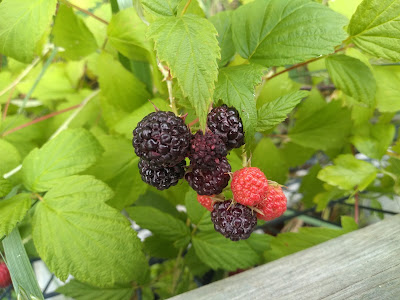A few years ago I bought an African violet. For some reason I don't see many African violets around these days. They are lovely little ornamental flowers with no particular use that I can gather beyond being nice to look at.
I have always heard that African violets are difficult to grow. My one has been easy to grow. It lives in a little self watering pot on my kitchen windowsill. Every few weeks I fill up the water reservoir, from time to time I remove dead flowers or dead leaves, and I rotate the pot occasionally to keep the growth reasonably even. Other than that it takes care of itself.
Up until recently it bloomed for most of the year, only stopping over winter when it gets too cold. My original one grows large ruffled blue flowers, it is rather pretty. It needs repotting and/or fertilising if it is going to keep flowering well. Using leachate from my worm farm seems to be good fertiliser for African violets.
At that start of winter I saw an African violet that had dark red flowers. I had heard how simple African violets are to propagate form leaf cuttings, so thought I would give it a try. I removed a leaf, put it in my pocket, and brought it home. When I got home I mixed potting soil with perlite, put this in a pot, watered it until damp, and planted my leaf cutting.
 |
| African Violet leaf babies |
I have heard that the plantlets are produced from the cut part of the petiole, and to produce extra plantlets you cut the petiole on an angle with the cut section facing up. I did this, I also nicked the petiole a little further up to see if it produced any extra plants for me.
Several months passed, the leaf looked fine, but nothing really happened. It can be very cold in my house over winter, so it is not unexpected that it did not grow during this time.
One day in early spring the potting mix looked like it had been pushed up near the base of the leaf. I looked closer and saw several tiny leaves. It looks like my leaf cutting worked, and the leaf cutting is producing several baby African violets.
Now the weather has warmed, the tiny plantlets have started to grow relatively quickly. The leaf itself still looks healthy.
I am still not sure how many plants it produced as the leaves of the baby plants are all close together. It looks like this leaf has produced three or four little plants. I am happy with that number.
I am told if you slit the end of the petiole about a centimeter or two that you should get a much larger number of plantlets, but they will be a bit smaller. I have taken a leaf cutting from my blue flowered plant and am trying this.
 |
| African Violet leaf babies |
 |
| Look how cute leaf babies are! |
I plan to let these grow a bit larger before I repot them into individual pots. If I divide them too early I risk killing them, if I wait too long to divide I risk stunting them, so it is a bit of a guesswork balancing act.
I think they are ready to be transplanted now, but am planning leaving them to grow just a little larger. I really don't want to lose them.
 |
| Leaf babies ready for transplant |
The mother leaf itself still looks remarkably healthy. If I cut it off just above where the plantlets are attached, I wonder if I could reuse the leaf as a cutting to produce even more plants. I would hate to lose my little leaf babies, so perhaps I will attempt this with another leaf at another time.
It is early summer here now. After repotting I have no idea how long until they will be large enough to flower, I am guessing it won't be before late spring or early summer next year at the earliest. From everything I have read it takes about 6 to 9 months to flower after being separated.
Edit to add: this post was written December 2023, the leaf babies were flowering March 2024, they had not yet been divided or repotted. The leaf cutting from my blue African violet has just started to grow baby plantlets. Perhaps the 6 to 9 months includes 3 months for the leaf to produce baby plants, and then another 3 to 6 months before they are large enough to flower. I have been told growing from seed takes a similar amount of time.
I would like to get a few more types of African violet. I don't have a lot of places in my house where I think African violets will thrive, so I will never grow a large number of them and will need to be picky about what varieties I grow.
Once my leaf babies are larger I will probably keep one and offer the others for sale or trade, or I may offer to sell leaf cuttings. If I do this I will try to list them on my for sale page along with the perennial vegetables, herbs, and vegetable seeds and things that I sell. I don't plan of selling them before they start to flower and I work out the best way to post them, so this won't be until some time from now.
















































